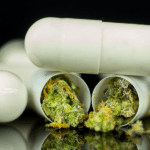Driving under the influence of cannabis (DUIC) is framed as a major risk associated with legalizing cannabis. Studies on cannabis and driving suggest that lighting up before getting behind the wheel increases crash risk between 25-40%.
This is equal to the effect of having a single drink one hour before driving. So although policy around DUIC needs to be decided, the danger does not warrant stalling medical or recreational legalization while impairment limits are determined. Doctors at a hospital in Vancouver recently published a prospective study meant to determine how THC in the blood is associated with the likelihood of causing a crash. These are somewhat flawed measures — blood levels of THC aren’t equal to the THC concentration in the brain, and culpability
inflates the supposed risk. But these measures can be a good proxy, in the absence of better data. The doctors found that low levels of THC (less than 5 ng THC/ml in the blood) was not associated with crashes. Higher levels of THC did not lead to a statistically significant effect, but appeared to fall in line with past research showing a slightly increased risk. Scientists are still trying to determine why the danger is not higher. It may be that cannabis replaces recreational alcohol use, so the total number of car crashes decrease. There is also evidence that stoned drivers drive slower and less aggressively, making up for some impairment in their reaction time. The Canadian researchers also tried to discern the effect of combining alcohol and cannabis. This couldn’t be reasonably analyzed in their data, however, the current evidence suggests that this is a quite dangerous combination.
Read study: Cannabis use as a risk factor for causing motor vehicle crashes: a prospective study
Adrian Devitt-Lee is a research scientist and longtime Project CBD contributor. © Copyright, Project CBD. May not be reprinted without permission.







